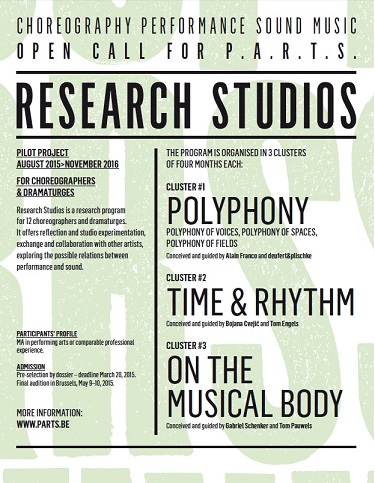August 24, 2015 – December 15, 2016
Cluster #2 : Time and rhythm
TIME OF DANCING - TIME OUT OF PROGRESS - TIME AND POP - TIME-IMAGES IN CINEMA AND DANCE - SOCIAL CHOREOGRAPHY OF RHYTHM - DURATION AND RHYTHMANALYSIS
Hit me with your rhythm stick / Hit me slowly, hit me quick./ Hit me… Hit me now…
The counterpart of the spatial dimension of figure in a geometrical approach to dance are time and rhythm, often foregrounded as the defining characteristics of dance in its dynamic dimension : the rhythmic pattern of the moving body. In the first place, dance owes its conception of rhythm to music : the organization of patterns comprising strong and weak beats within a pace of the flow of time (metric pulse, tempo). The exploration of rhythms and tempi from within time which is regulated by music is then composed with the biological sense of corporal rhythms (e.g. breathing in release technique, walking in pedestrian movement). While it traditionally harks back to the historical marriage between music and dance, rhythm affords an instrument for a study of the parameter of time in a broad, expanded and transdisciplinary sense of artistic practice and critical analysis. For the performing arts as time-based arts, rhythm and time are a matter of composing and manipulating attention and experience ; they refer to the relative sensation of time accelerated, contracted or condensed, expanded or dilated, as if time in a metaphysical sense didn’t exist.

Two additional lines of thought intersect in the problem of rhythm in a wider sense. Firstly, it is the ancient Greek etymology of rhuthmos as “a form of moving” together with the social anthropological perspective of “man as a rhythmic animal” (Marcel Mauss). Secondly, it is “the inextricable link between power and rhythm. What power imposes in the first place is a rhythm (rhythm of everything – life, time, thought, discourse)” (Roland Barthes). Thus, an investigation of rhythm from the viewpoint of bodily movement doesn’t stop at the aesthetic play of sensations in the creation and the spectator’s experience of a dancing body. It passes through all other domains in which the manner of flow – of bodies, language, images, events, noise and intensity – can be observed. Throughout the 20th century, a characteristic expression of homorhythmy has been registered as the blueprint of modern industrial capitalism, most prominently the rhythm of the “human machine” in Rudolph Laban’s study of effort after Taylorism, or the theory of managing workers’ movements on the assembly line.
Today both performance and work are far from stomping unisono in the same rhythm and cadence. Working and performing in post-industrial post-Fordist society resembles more an attempt to dance ¬ex tempore and conceal a choreographic script or score in improvisation as a form of individuation. The virtuosity of multitasking and nomadism in life and work styles parallels the sophisticated forms of polyrhythmy in contemporary dance and performance.
We don’t know enough about the rhythms in which we dance, produce, consume, or gather today. It takes a transdisciplinary effort from a heterogeneous set of perspectives to study temporality and develop rhythms beyond those we are familiar with. Therefore, the bloc TIME AND RHYTHM is conceived as an intensive period of research in theoretical study and practical experiment with artists and thinkers who have explored a variety of expressions and problems of time and rhythm in their work. It includes
- seminars in the theories of time and rhythm : “time out of progress” (on labor and projective time, with Bojana Kunst, Giessen) ; social anthropology of rhythm (Pascal Michon) ; time in the philosophy of pop culture (Diderich Diderichsen) ; time-images in contemporary dance, performance and cinema (Bojana Cvejić, Brussels)
- workshops and collective studio sessions with choreographers (Eszter Salamon, Nikolina and Goran Sergej Pristaš, Mårten Spångberg, composers (tba) and theatermakers (Tim Etchells)
- creation time of students (5 weeks without curated program)
…time accelerated anachronous circular contemporary contracted dead delayed diachronic dilated disrupted fragmented heterochronous historical hypersynchronized linear ontological organic out-of-joint projective psychological synchronous…

